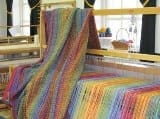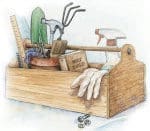Weaving
“Your way of acting should be different from the worlds’ way
The love of Christ must come before all else.”[1]
RB 4.20-21
Advent may be my favorite liturgical season. As the days become shorter and darker, the desire to be embraced by stillness grows deeper – to fix a warm cup of tea, to become lost in a book that draws me closer to the heart of Christ, to ponder the words of prophets or the journey of Mary or, especially, to just be still. Truth is, reality is usually a different picture…
Hurry, hurry, on the run.
Rushing, shopping, never done.
Meetings, work, the job to do,
Pick up an extra shift or two.
Get out the recipes, plan what to make,
More shopping to do before I can bake!
More gifts to look for, will I ever be done?
More parties to go to, my life’s on the run.
That carol I’m hearing going round in my head,
Do I really mean it, is that what I’ve said?
“Come into my heart, Lord Jesus,” the words are my own.
But how can Christ come? I’m never at home.
From “Hurry, Hurry” by Mary McCall Kulberg
Entering the season of Advent we become acutely aware of our busy lives as even more things to do are piled upon an already busy schedule—baking cookies for friends or teachers, buying gifts not only for loved ones but for people we do not know, attending school holiday concerts, decorating the house, visiting friends and families, cooking meals and cleaning house. Do you sometimes feel that you have lost control of your life? Are you rarely “at home?”
Author Phyllis Tickle once observed that modernity has desanctified our external life, causing us to separate our experiences into categories and to “speak of our spiritual life as if it were different from our work life or our domestic life.”[2] The result is that we view some activities as spiritual, like church, reading the Bible or prayer, and view the rest as secular. What you and I need to do always, but especially in busy times, is to be intentional about bringing all parts of our life together into one sanctified whole so that we can embrace the reality that all of life is infused with God’s presence and peace. Benedict would ask us to act differently from the usual world’s way—to put the love of Christ first in how we approach everything (RB 4.20-21) and to “prefer nothing whatever to Christ.” (RB 72.11)
And so, might I suggest that we become weavers? Don’t panic. No need to run out and buy loom and yarn, although there must be much that is satisfying and peace-bringing about working at a loom and seeing something beautiful emerge. What I’m suggesting is that we find a way to weave all parts of our life together into a sacred whole.
To weave, a loom is set up with scores of threads or yarn that run lengthwise front to back from where the weaver sits. These threads are called the “warp.” The weaver wraps a small device called a “shuttle” with more thread or yarn that is called the “weft,” an Old English word meaning “that which is woven.” The shuttle is then tossed back and forth amongst the warp threads. The weaver works foot pedals that raise the warp threads in various configurations resulting in the pattern on the woven cloth. So cool!
Here’s my idea. You and I sit at the loom of our life. Each warp thread is a facet of our life, an activity, a role, a responsibility, a task, a community that we are a part of. There are many colors and textures, some bright and shining, some dark and dull. As we look intently at the warp, the combination may be beautiful. Yet the threads serve no greater purpose than just existing by themselves. There are spaces between each thread so that nothing can be held or supported. The threads of the warp are isolated and weak. This is  what the many facets of our lives can seem like at times—separate and stressful occurrences serving no purpose except to be dealt with and finished. Like the warp on a loom, they need to be joined together into a holy unity. And so we use the shuttle to weave the woof yarn into the warp. What is the shuttle? Christ is our shuttle! The yarn of who he is will join the warp of our lives into a solid and glorious unity; a unity that is strong, purposeful and purpose-filled. Jesus tells us how to work the foot pedals, so that his presence can create special patterns of infinite beauty, unique for each one of us. As we toss the shuttle of Christ back and forth through the threads of the loom, with him we weave together the myriad piece parts of each year, each day, each hour, each minute. The warp of life begins to make sense as we see everything as it is joined together by Christ.
what the many facets of our lives can seem like at times—separate and stressful occurrences serving no purpose except to be dealt with and finished. Like the warp on a loom, they need to be joined together into a holy unity. And so we use the shuttle to weave the woof yarn into the warp. What is the shuttle? Christ is our shuttle! The yarn of who he is will join the warp of our lives into a solid and glorious unity; a unity that is strong, purposeful and purpose-filled. Jesus tells us how to work the foot pedals, so that his presence can create special patterns of infinite beauty, unique for each one of us. As we toss the shuttle of Christ back and forth through the threads of the loom, with him we weave together the myriad piece parts of each year, each day, each hour, each minute. The warp of life begins to make sense as we see everything as it is joined together by Christ.
All you and I need to do is pick up that shuttle.
We can do this by recognizing that Christ is present in all of life. Benedict tells us that the Divine Presence is everywhere (RB 19.1) Shopping? Christ is there. Decorating the house? He is there too. Filling the house with Christmas carols? He is definitely present. As we do our work we can envision the shuttle of Christ making sense of it all, bringing all into a unity, making all holy and blessed. We can also pause even briefly throughout the day to envision the loom and Christ who brings all together. We can be at home with him and let him help us see everything we do as infused with his life-giving and creative spirit.
Have a blessed Advent!
Jane
To see the Tool for this article – A Tool for Weaving Christ into Your Life, click here.
© November 2012 The Rev. Dr. Jane A. Tomaine
[1] RB quote is taken from the translation found in RB 1980 – The Rule of St. Benedict in English. Ed. Timothy Fry, O.S.B.
[2] Alive Now, Nov/Dec, 1997, p.23. Alive Now is a wonderful resource for story, poem and spiritual inspiration published by The Upper Room. Please check it out!
The photos in my article are from The Kingston Handloom Weavers and Spinners Guild. The guild has been in existence since 1948 and is a not-for-profit corporation that promotes the teaching of weaving, spinning and other related crafts in both their historic, contemporary and technical context to interested community members of all ages.

